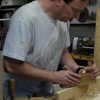I have really enjoyed looking at the many beautiful and functional backsaws/dovetail saw that have been built by contributors to this forum. I have finally worked up the courage to give it a try myself. I would prefer to buy the components for Mike W. but understand that it's not currently possible. I know I can purchase the saw kits, including sharpened blades from Gramercy, but that's a little out of my price range.
I'm looking for suggestions about where I might be able to purchase slotted brass for the saw backs and spring steel for the blades? I would prefer slotted brass over fold brass given I don't have any metal working tools even a metal vice. If I can't get slotted brass backs, I guess I could fold flat brass stock myself with my twin screw,woodworking bench vice, but I'm afraid I might not be able to get it straight.
From one I've seen here at Neanderthal Heaven, I believe the most appropriate steel would be "1095", but I know nothing about metalworking and would appreciate any comments or suggestions from the many expert and knowledgeable contributors here!
I am interested in blade thicknesses of .018", .020" and .025" - is it possible to buy the appropriate type of spring steel in these thicknesses?
I have built many replacement handles and sharpen/set many vintage hand saws, but have never built any from scratch and really appreciate any guidance or suggestions.
Thanks in advance, Mike Allen




 Reply With Quote
Reply With Quote




